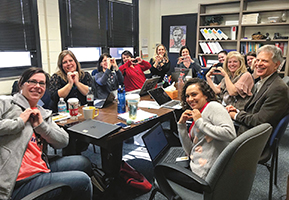Cultural Glue for Binding an Unstable World
April 01, 2018
The need for a framework of common expectations and beliefs when school communities face ambiguity and uncertainty

One could argue that pre- and early teens always have mocked perceived and actual differences from what is “in” with their peers. So, the complaints, while hurtful to those mocked, might well be considered nothing new.
But in today’s nationwide climate of ambiguity over culture and values, I wondered whether there might be more to it. Might the national debate over perceived Russian influences in American elections be contributing? Or the idea that political camps of all stripes now rebuff the notion of compromise for a strict ideological purity? Or that more and more communities are ethnically and culturally diverse? Or that electronic devices allow for instant communication of unfiltered thoughts or opinions from any and all sources? Or that it is becoming more and more difficult for people of all ages to disagree in a civil and productive manner?
Universal Norms
All of the above contribute to identifying a universal set of cultural norms and values — something I’ll call “cultural glue” — harder to accomplish. Today there is a higher probability that a public school no longer can simply attach itself to a set of community norms and values, mainly because a clear and established set of community norms and values often doesn’t exist. In this day and age, it increasingly looks like schools have to establish their own cultural glue.And let’s face it. Schools need cultural glue.
In my early days as a principal, my K-6 school in the suburbs south of Chicago received a U.S. Department of Education Blue Ribbon Award not because of its impressive academic achievement — our achievement scores were good but not great — but because of a strong school culture built around the values of being pleasant, polite and productive, our “3 P’s.” Those values were the core of that school’s approach to learning, and they united the student population of 70 percent African American and 30 percent white, the 80 percent white and 20 percent African-American staff and the larger parent community.
There was no need to translate the “3 P’s” to those within or outside the school. Back then, they were instantly identifiable to everyone and considered universally desirable values by staff, parents and students alike. That school had some powerful cultural glue!
Selling Culture
But that was several decades ago. How many communities today would seriously rally around the need to making “pleasant and polite” cultural imperatives?Yet what happened then still can happen now. I recently saw an example in a K-5 school just west of Chicago that actively promotes its “3 R’s”: rigor, relevance and relationships. This school created its own cultural glue. But unlike a few decades ago, now it has to “sell” that culture to an ever more diverse set of mixed student, parent and community values and cultural beliefs.
A school’s cultural glue represents a linkage to universally clear expectations around why we are in this particular school — its mission, vision, values and beliefs. My coaching work, currently for the Consortium for Educational Change, is spent as much in helping schools and districts identify their own unique cultural glue as it is in helping them implement continuous improvement structures and processes.
A school’s cultural glue really sticks when expectations around values and beliefs translate into common actions and behaviors by everyone — students and adults alike. However, when there are no common schoolwide expectations, a culture of dysfunction emerges by default. Everyone invents his or her own cultural imperatives. There is no cultural glue by which to bind the school together, and as a result, students and staff alike suffer the consequences.
Cultural Dissonance
Here’s one example of cultural dissonance. The same middle school in that suburban Chicago district with Hispanic and white students faced significant behavioral issues, not the least due to a lack of schoolwide expectations around behavior. Behavioral expectations varied from hallway to hallway and classroom to classroom. For instance, students testified they weren’t supposed to verbally bully each other. But they cited examples of adults in the school calling students names. So verbal bullying became an expectation to ig-nore rather than to follow.This school now is building a common set of learning and behavioral expectations to which teachers and students alike can commit. It is becoming “tight” around common cultural imperatives that describe in actions and behaviors what the school stands for and believes. But going forward, those cultural imperatives also must accommodate both white and (multiple) Hispanic cultural values within an economic range from disadvantaged to solidly middle class.
This can make identifying a school’s cultural glue a complex task, particularly in highly divergent communities. I currently coach two suburban districts where, in each, there are 40 or more student languages represented. The cultural expectations for these schools can bump into ingrained family cultural norms that do not always fit with American approaches to schooling.
For instance, one K-8 district has Pakistani kindergartners who are regularly late for a noon school start. Counselors making home visits discovered that these families typically stay awake long into the night, and sleeping past noon is culturally normal for many of them.
Even when there is a clearly identifiable community culture, the values may not be a match for what a successful school requires. A high school district where I spent three years as a systems coach exists within a severely economically disadvantaged community with a high unemployment rate and a significant gang presence. It has a long-standing history of contentious board infighting, volatile school board elections and hard-edged labor-management-board relationships.
Why such a history? The school district, by far, is the largest community employer in an area bereft of employment opportunities. Therefore, the district has become a battle-field for politically linked jobs. Because the politics of this community are volatile and ever-changing, a steady focus on learning has been subsumed by politically driven competition for jobs and influence within the school district.
Obsessive Parenting
On the other end of the spectrum, I have led and consulted in wealthy suburban districts where the cultural obstacles are completely different but just as difficult to overcome. The community culture is often one of individual entitlement where, not infrequently, “helicopter parents” hover around the school demanding preferential treatment.To illustrate the point, as the superintendent in one wealthy district in the Chicago suburbs, I recall defending the district’s approach to gifted education before a prospective parent considering moving into the community. Only after an hour of detailed explanation did I discover that the gifted child in question was still in the womb.
In both the politically dominated and entitled districts, the community cultures were clearly identifiable. However, each was ill-suited to provide its public schools the appropriate cultural glue for those schools to thrive and continuously improve.
A North Star
At a time when expectations for schools are exponentially increasing due to technological innovations, cultural ambiguities, political gridlock and diversified school populations, schools now, more than ever, need the north star of cultural glue. With it, schools can build from a framework of common expectations and beliefs as the world around it becomes ever more rapid and complex. Without it, no improvements can be sustained when there is nothing culturally permanent to which to attach.Don’t think for a moment that any school improvement plan will succeed absent some solid cultural glue. Cultural glue is required to provide a receptive host for any long-term, sustainable school improvement efforts. And what is increasingly clear is that schools, more likely than not, will have to generate such cultural glue largely on their own.
Author
Additional Resources
Author Mark Van Clay suggests these informational resources relating to the subject of his article.
»Consortium for Educational Change, which works with districts on a systemic, collaborative approach to build internal capacity
»Drive: The Surprising Truth About What Motivates Us by Daniel H. Pink, Riverhead Books
»The Ideal Team Player: How to Recognize and Cultivate the Three Essential Virtues by Patrick Lencioni, Jossey-Bass
»Maximize Performance: Creating a Culture for Educational Excellence by Quint Studer and Janet Pilcher, Studer Group
»Radical Rules for Schools: Adaptive Action for Complex Change by Leslie Patterson, Royce Holladay and Glenda Eoyang, Human Systems Dynamics Institute Press
»Transforming School Culture: How to Overcome Staff Division by Anthony Muhammad, Solution Tree Press
Advertisement
Advertisement
Advertisement
Advertisement


